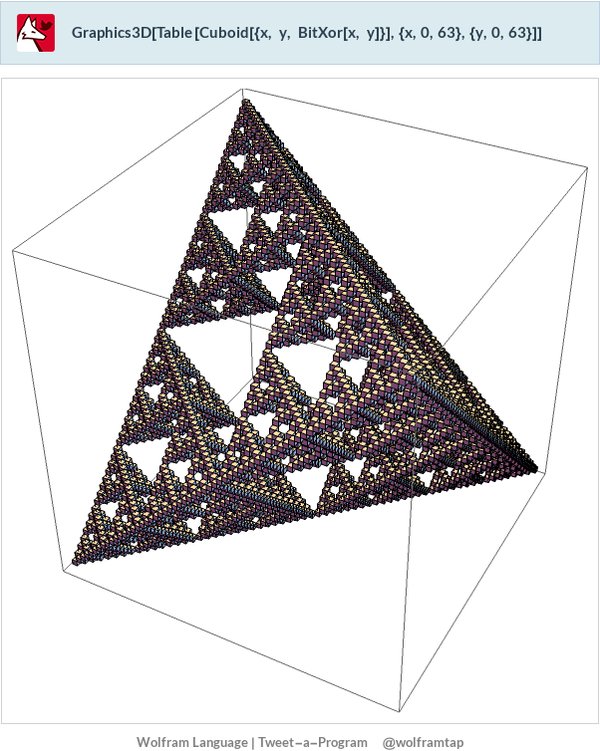Sierpinski triangles arise as matrices whose characteristic polynomials expectedly and unexpectedly factor nicely as products of linear and quadratic polynomials. For this answer, I have observed these phenomena experimentally, but I do not have a formal proof that these phenomena always hold.
Let $A=\begin{bmatrix}
0 & a \\
b & c
\end{bmatrix}$.
For $n\geq 1$ and for each matrix $B$, define the tensor power $B^{\otimes n}$ by letting
$B^{\otimes 1}=B$ and by letting $B^{\otimes(n+1)}=B^{\otimes n}\otimes B=B\otimes B^{\otimes n}$. The matrix $A^{\otimes n}$ is a depiction of the Sierpinski triangle.
Now, if $A$ has eigenvalues $\lambda,\mu$, then since the eigenvalues of
$A^{\otimes n}$ are precisely the elements of the form $\lambda^{n-i}\mu^{i}$ for $0\leq i\leq n$, it should not surprise any mathematician that the characteristic polynomial $A^{\otimes n}$ can be factored completely into linear or quadratic polynomials with coefficients in $\mathbb{Z}[a,b,c]$.
Let $P_{n,k}=(a_{i,j})_{1\leq i\leq n,1\leq j\leq n}$ be the matrix where
$a_{i,j}=1$ if $i-j=k\mod n$ and $a_{i,j}=0$ otherwise. Then I have experimentally verified that characteristic polynomial of the matrix
$A^{\otimes n}\cdot P_{2^{n},k}$ can also be factored as a product of linear or quadratic polynomials with coefficients in $\mathbb{Z}[a,b,c]$ (This is the shifted Sierpinski triangle). Furthermore, if $N$ is a $2^{n}\times 2^{n}$-matrix where almost all of the entries are zero, then the polynomial
$\text{char}(A^{\otimes n}\cdot P_{2^{n},k}+N)$ still has a quite decent prime factorization.
For example, if $n=8,k=7,a=b=c=1$, then $A^{\otimes n}\cdot P_{2^{n},k}$ has characteristic polynomial
$(x-1)^{20}(x+1)^{28}(x^2-18x+1)(x^2-11x-1)^{3}(x^2-7x+1)^{3}(x^2-4x-1)^{3}(x^2-3x+1)^{19}(x^2-x-1)^{33}(x^2+x-1)^{9}
(x^2+3x+1)^{12}(x^2+4x-1)^{15}(x^2+7x+1)^{6}.$
If we replace $A$ with an arbitrary $2\times 2$ square matrix or even a lower or upper triangular matrix, then the characteristic polynomial of $A^{\otimes n}\cdot P_{2^{n},k}$ usually does not have a good factorization.
If $A_{1},\dots,A_{n}$ are $2\times 2$-matrices where if $A_{r}=(a_{i,j,r})_{i,j}$, then
$a_{1,1,r}=0$, then the characteristic polynomial of
$(A_{1}\otimes A_{2}\otimes\dots\otimes A_{n})\cdot P_{2^{n},k}$ is usually reducible, but this characteristic polynomial often cannot be factored as a product of linear or quadratic polynomials, but if the underlying field is finite, then this characteristic polynomial factors as a product of linear or quadratic polynomials.














